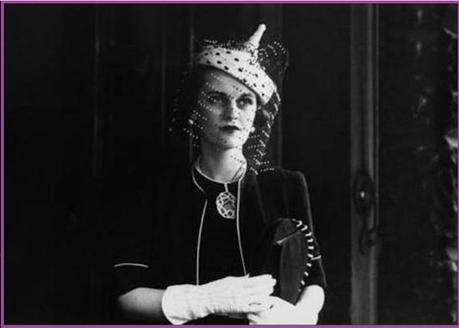I was already aware of the scandal attached to those events of 1963 because of a curiously tenuous connection between the Duchess and my own family. In brief, when my ex-mother-in-law first graduated from university in the early 1950s, she taught English Literature for a while at a sort of finishing school for young ladies in London. One of her pupils was Frances Sweeney, the daughter of the socialite who had recently become Margaret, Duchess of Argyll. I don't know how well the two women knew each other, but when my ex-mother-in-law became pregnant with her first child and set to leave her position, the Duchess gifted her a christening gown, allegedly saying "you've probably got lots of these but I'd like you to have it". It's an item which her daughters, including my ex-wife and then our daughters in turn, wore when they were christened. Consequently there was much talk in the family about the Duchess when news of her death was announced in 1993.
A Very British Scandal portrayed Margaret (played by Clare Foy) in a reasonably sympathetic light as a red-blooded woman being taken advantage of by a mercenary, blue-blooded husband who was only ever really after her money to restore his Scottish castle. He was also an adulterer, a cheat, had a drink problem and an amphetamine addiction, and was quite prepared to play dirty and shame the Duchess in order to divorce her when the money ran out - and yet the establishment sided with him.

the Duchess of Argyll
In real life, Margaret, daughter of Scottish millionaire industrialist George Whigham, was a sultry beauty from an early age. Aged fifteen she became pregnant by David Niven and had a hush-hush abortion at a London clinic. At eighteen she was presented at Court in the 1930 debutante season and was soon popular in socialite circles, numbering Prince Aly Khan, Max Aitken (later Lord Beaverbrook) and Prince George, Duke of Kent among the men with whom she had youthful affairs. At one point she was engaged to Charles Greville, Earl of Warwick, but broke it off in favour of marriage to an American businessman Charles Sweeney. Her wedding dress was designed by Norman Hartnell and was the talk of society papers for weeks.She was with Charles for fourteen years. The couple had two children, the afore-mentioned Frances and a son Brian, but that only after a string of eight miscarriages and a stillbirth. She nearly fell to her death when she opened a lift door and stepped directly into the lift shaft (for the lift was actually stopped at the floor above). She fell forty feet, was hospitalised and told she would never walk again, but she made a remarkable recovery. She eventually divorced Charles Sweeney on the grounds of his serial adultery, but remained friends. He lived in Mayfair for the rest of his life and died just a few months before Margaret, in 1993.
Four years after her divorce from Sweeney, Margaret agreed to become the third wife of Ian Campbell, the 11th Duke of Argyll. Her money, and a loan from her father (that the Duke defaulted on), were used to restore Inveraray Castle, home of the Argylls, to its former glory but Margaret soon became aware of the Duke's violent mood-swings, addictions, manipulative ways, frequent absences and infidelities. She felt lonely and taken advantage of, so resorted to spending most of her time at her London home, resuming the social life she had known before her marriage to the Duke, though holding out the hope that she could reform him and that they might be reconciled. It wasn't going to happen, largely because of his own insecurity and profligacy. He was soon determined to be rid of her by any means possible so he could take up with another rich and more compliant heiress.
What the recent dramatisation failed to put across were two key things. The first was that there was a precedent for what Ian Campbell was doing. His great uncle, Lord Colin Campbell, had divorced his wife Gertrude eighty years earlier in what was the longest and most sensational case to date on similarly unproven grounds, that Gertrude had become involved with the Prince of Wales (who was named as co-respondent). He counted on the inference of a woman being immoral as weight enough to condemn her. The second was that the speculation about whether Ian was really father of his second wife's children came not from Margaret in a spiteful attempt to unsettle him, but from Ian's own doubts about their paternity. Louise Clews was going to issue a writ against her ex-husband for his claims and so he persuaded Margaret to go along with a story that the speculation was hers. His own embarrassment over the matter, coupled with Margaret's refusal to advance more money to him determined him to get rid, just as his great uncle had done. Ian employed a locksmith to break into her house in her absence and steal what he hoped would be incriminating evidence against her. Love letters (pre-dating their marriage), her intimate though cryptic diaries and some polaroid photographs were his haul. He tried blackmail first of all, suggesting that a discreet separation would be possible if she would pay him £250,000 to keep quiet.
Margaret decided to challenge conventions. She sent him packing and said she'd see him in court, even proposing a counter-action at one point, to cite him for divorce either on the grounds of cruelty or of adultery with her own mother-in-law (of which she was convinced although she had no proof). She believed that the law would see the justice of her case.

the Polaroid 95 'instant' camera
In the end, the Duke's action was the one which went to court in Edinburgh in 1963. He claimed that Margaret had had eighty-eight lovers, that 'v' when it appeared in her diary was a cipher for having sex, that a photograph of her hugging a man on her doorstep at 3am and that certain blurry polaroids of his wife naked in the presence of another man were sufficient proof of her adultery. Extracts from the love letters were read out. The Duchess denied having an affair with the man hugging on her doorstep. She refused to say what 'v' signified. What she couldn't deny was the evidence in the polaroid pictures. It was unmistakably her, wearing her instantly recognisable triple string of pearls and nothing else, in her own bathroom, with a man who, although his head was out of frame, was not her husband. She refused to say who it was.
The judge, a staunch Catholic and also a member of the clan Campbell, refused to believe that a Scottish Duke could ever be a liar and a cad. He'd seen enough to castigate the Duchess as a woman of immoderate and indecent sexual desires, "a completely promiscuous woman whose sexual appetite could only be satisfied with a number of men" and in a four-hour summing up granted the Duke his divorce on the grounds of Margaret's adultery with the man on the doorstep. The first irony is that the man in question was no more than a genuine friend, and a homosexual as well - but that was illegal at the time, so although the revelation would have harpooned the adultery allegation, Margaret was not prepared to out her friend in that way. The second irony is that although the Duke was ordered to pay one eighth of the costs of the trial, the Duchess was ordered to pay the other seven eighths. The third irony is that within weeks of the divorce, the Duke was married again, for a fourth time, to a wealthy American heiress from whom he could sponge.
Much was made in 1963 of those polaroid pictures of the naked Duchess and the 'headless' man, most of it gratuitous speculation as to who the man might be. Bizarrely. Lord Denning was brought in by a Tory government still reeling from the scandal of the Profumo affair to try and identify the 'headless man'. The actor Douglas Fairbanks Jr. and Duncan Sandys, then Minister of Defence, were on the hot list. Sandys even offered to resign his cabinet position in light of the rumours. But Margaret refused to name names. In fact she never confirmed or revealed the names of any of the men she was supposed to have been involved with. Neither did she ever re-marry. She maintained discretion and retained her dignity to the end of her days.
To finish off, so to speak, a saucy little poem suggested by the photographs of intimate events in her bathroom which in themselves were, I imagine, both an exciting and a tender memory for the Duchess, but which in the hands of her spiteful husband became what is known nowadays as 'revenge porn'.
The Perfect Polaroid MomentHer bathroomHer pale skinString of pearlsOn her kneesEyes closedIn concentration.Her lover heldThe cameraPointing southHand steadyReady to shootThe consummation.He stood straight He stood tallTorso tannedYou couldn't seeHis head at allIt was in her mouth.Happy New Year and thanks for reading, S ;-) Email ThisBlogThis!Share to TwitterShare to Facebook
